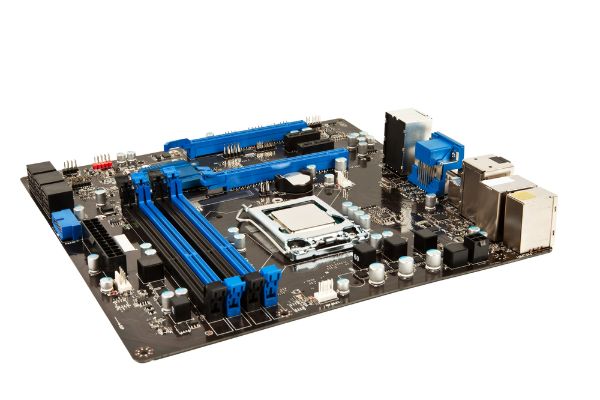Disclaimer: This post may contain affiliate links, meaning we get a small commission if you make a purchase through our links, at no cost to you. For more information, please visit our Disclaimer Page.
Your computer’s motherboard acts as a hub of sorts, and it connects many of the other important components inside your PC to each other. Some of these connections are physical, and it can send data to one component that might be connected to several others.
In this way, it can chain relevant information together, and it helps the processor do what it needs to do in order to execute functions and keep the device working. Some motherboards come with Wi-Fi modules, and others do not.
Because this is such an important piece of tech, we will go over the differences between Wi-Fi motherboards and those that don’t have it enabled. Internet access is also a huge factor for most modern PC or laptop users, so we will cover how you can connect to Wi-Fi if your motherboard doesn’t have the option, too.
Finally, we’ll touch on what you can do without a motherboard capable of Wi-Fi, and whether there could be any possible issues if you do use a board that has it.
Table of Contents
What’s the Difference Between Wi-Fi & Non-Wi-Fi Motherboards?
In short, a Wi-Fi motherboard will have a Wi-Fi card that is attached to the board itself. As you might expect, its counterpart would not have this.
If you do have a motherboard that can access Wi-Fi on its own, you won’t see the jack where you can plug in the appropriate antenna for Wi-Fi access. This is the main difference between the two types of motherboards, but it can get a bit more nuanced than this.
A motherboard with Wi-Fi built into its framework provides an aspect of portability. This kind of thing is important for laptops, even if you mainly use your own laptop in lieu of a desktop rig. You always have the option to take a laptop with you and work from anywhere, and that kind of form factor needs to get internet access to you in a way that doesn’t rely on wired connections. Having to deal with wired connections is a more stationary thing, and it would defeat some of the purpose that a laptop computer is designed to fulfill.
Conversely, however, desktops can have Wi-Fi boards, but they may have less of a need for them. There are occasions for which you may want to pack up your whole desktop setup and move it to another room or location. Most desktops are designed as form factors that are meant to remain where they are, though, and this is true for the home or office.
Because of this, a standard PC doesn’t have as much of a need for motherboards with Wi-Fi cards. There are several things on a desktop that you’ll need to plug in or hookup, and making a wired connection for internet is just one more thing you can take care of when you do this.
Can You Connect to Wi-Fi Without a Wi-Fi Motherboard?
Yes, you can still access the internet if you have a motherboard that does not have a Wi-Fi card. There are a couple of ways you can do this.
Which one you choose may depend on the equipment you have available to you already, your preferences, or any plans you have that may have data limits. You can connect the computer to Wi-Fi using either a piece of tech known as an adapter, or your own phone.
To connect your computer using an adapter, you need only purchase the unit and plug it into your PC via a USB port. There may be some basic steps involved in setting everything up, but it should not take long to do so. Once you have done this, the adapter will then serve the same function as if you did have a Wi-Fi card inside the computer.
Your device will be ready to communicate with any wireless networks in the area. Note, however, that you’ll still need to set up your own network first. If you’ve done this, or you know the appropriate security key, you can have your computer get on the network and gain access to the internet this way.
Several companies that make routers and other internet-related equipment will also sell adapters. They are small devices that look like tiny versions of flash drives. You should be able to find these items from many reputable brands, and they usually sell them at inexpensive prices.
The other thing you can do is connect to a network via tethering. Tethering involves you using your phone’s data service as a mobile hotspot. In order to facilitate this, there are just a few steps you need to follow.
The guidelines we’ve listed below are general in nature, and some of the headings or settings may be under slightly different names, but this will depend on the make and model of the phone you have. However, the instructions here should be able to help anyone with a modern smartphone enable tethering. To do so, follow these steps:
1. Enable the Wi-Fi Networks setting on your phone. This will turn on your phone’s Wi-Fi and have it search for available networks. If this is your first time doing so, you will need to enter the appropriate security key in order to access the network of your choice.
2. Use a USB cable to connect your phone to your computer physically via a wired connection.
3. Once the computer recognizes your smartphone, go into your phone’s ’Settings’ menu and look for something regarding ’Networks and Connections’.
4. After you get into the appropriate submenu, you can enable mobile hotspot or USB tethering as options.
5. Doing one of these things will give your computer a connection to your phone, and the phone will connect to the Wi-Fi network normally. Through the phone, your computer should now have internet access by proxy.
The only thing to note here is a possible caveat. It is both rare and dependent upon your provider, but some phones or plans may not offer options to tether or create hotspots.
Even smartphones that are several years old should still do this, but there are some regional providers that may offer plans and phones that simply don’t have this option. It is not very common, but it is worth mentioning here. If you find yourself with such a setup, you can still use an adapter to get your computer on the internet.
What Do I Do if My Motherboard Doesn’t Have Wi-Fi?
If we assume that you have a desktop rig without a motherboard that has Wi-Fi, let’s explore at least one other option that is open to you. You can connect it directly to the modem for internet access via ethernet. Your motherboard should have a port for ethernet, and you’ll just plug one end of this cord into that, taking the other end to put into the modem.
This would make it a wired connection, however, and you would bypass the router entirely. You could still put one end of the cable into the back of an appropriate port that you’ll find on the router.
If you have multiple devices that you need to connect in this way, that may be easier for you. It can also depend on where your internet tech is located, and routers are sometimes easier to access than modems.
If you do have access to the modem and don’t need to move the computer around much, however, a wired connection can offer stability. It is also possible for wired connections to offer higher speeds. However, you may already be reaching speeds that are close to the peak through your wireless connection, depending on the specific package you have from your internet service provider.
Can a Motherboard Cause Internet Issues?
Yes and no. Most motherboards will use network interface cards to help your computer with connectivity. Modern boards should have NICs that have a gigabit range. In most cases, these cards should be able to help your computer connect to the internet at any speed that your current package provides.
The hardware involved should be capable of handling even the fastest kind of internet that might be available from your ISP. This is true even if the tech on your NIC is a bit old, outdated, or not functioning at its best. For motherboard’s like this, problems specific to the internet should be so small as to be negligible.
If you do have a board that is capable of Wi-Fi, there are possible internet issues that could occur, but they are not likely. With such a board, it may only support particular internet protocols. This would be dependent on the make, model, and age of your Wi-Fi motherboard. If it is causing any issues with the internet, it may be because it only supports a slower protocol than that which your router is designed to handle. Most modern boards made within the last few years should not affect your internet speeds or stability, though.
Conclusion
Wi-Fi-enabled motherboards are great for making sure you can have access to various networks when you are out and about. However, they are not the only way you can connect to the internet.
Desktop rigs may favor wired connections, but you can also use adapters or smartphone technology to achieve the same results. Modern motherboards of either type are unlikely to have any significant impact on your internet speeds.


